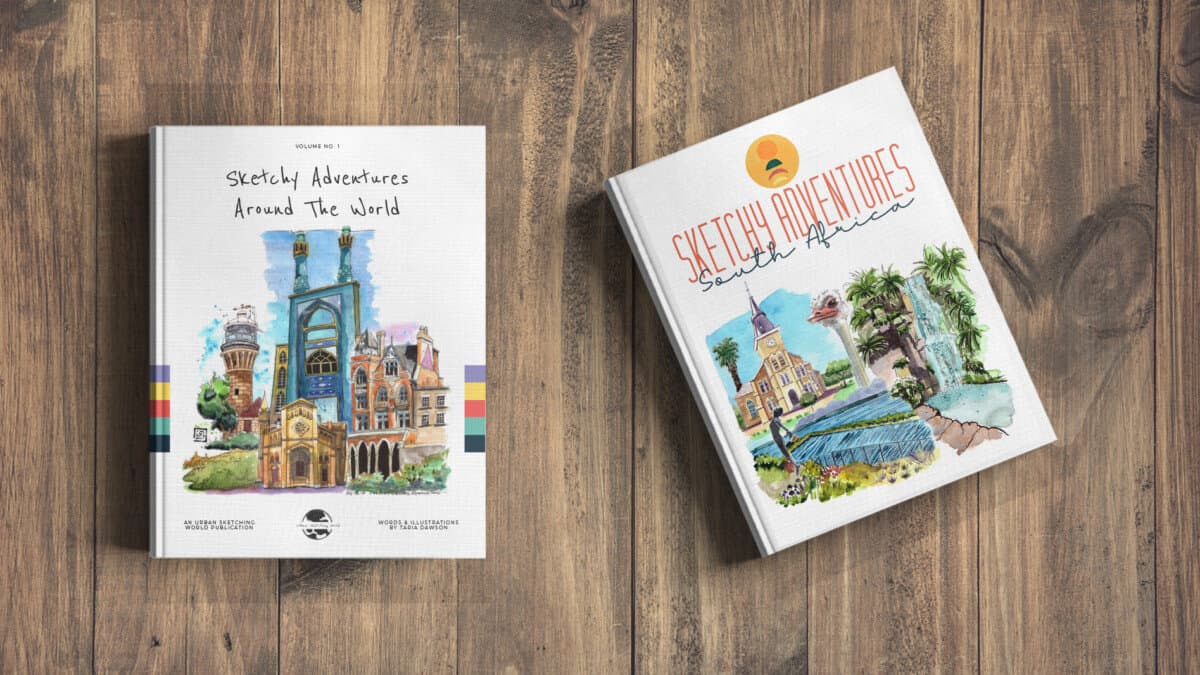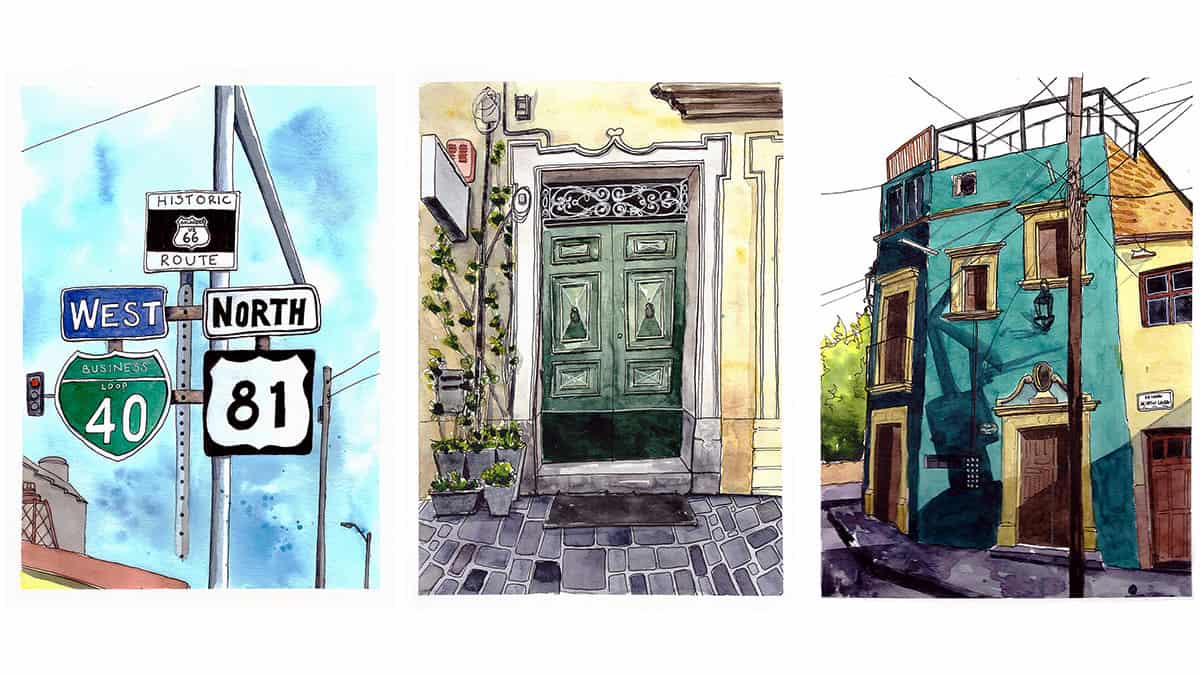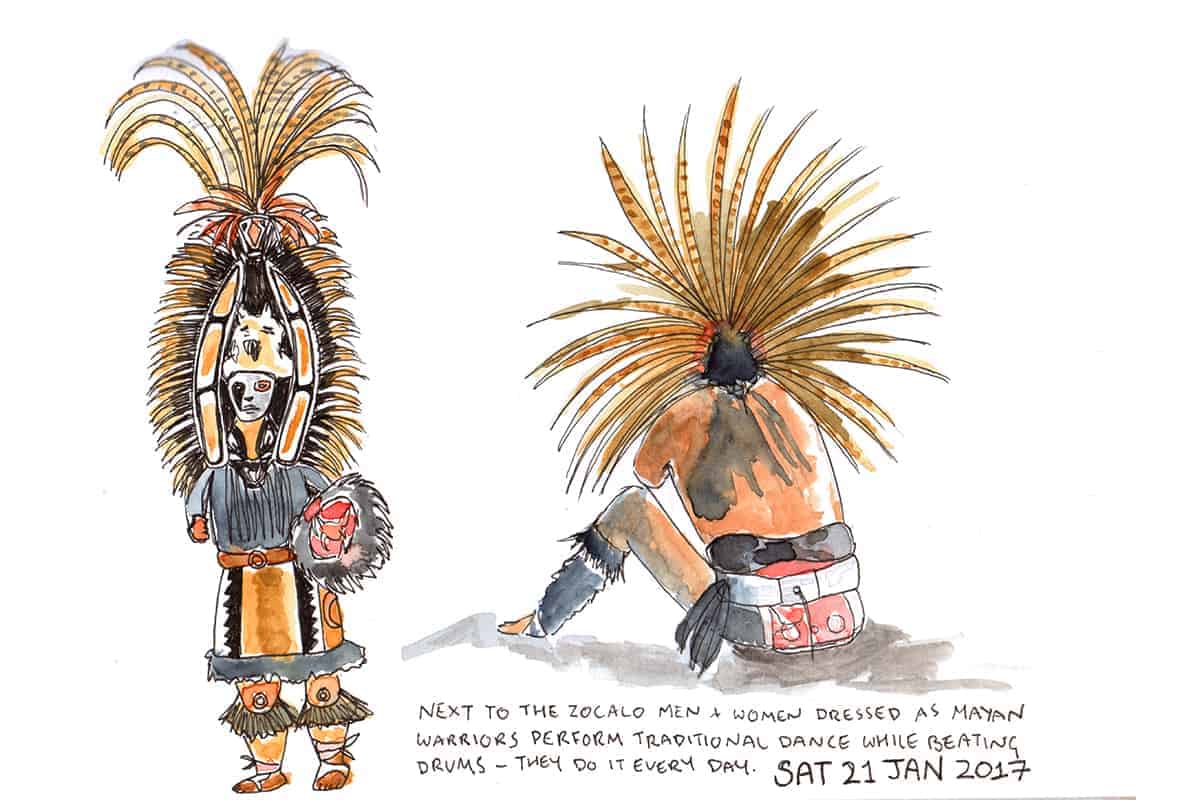Reportage illustration is a type of visual journalism. Reportage illustrators sketch on location to tell a specific story. The illustrator conveys a narrative and reports a specific moment in time to the audience, much like a journalist. The central premise of reportage illustration is storytelling.
“Reportage illustration is the art of recording real events and situations by hand on paper, just as a photo journalist would use a camera to record them for a magazine or newspaper feature.” – University of Arts London (UAL)
When Did Reportage Illustration Start?
A publication called The Illustrated London News was first published in 1842. The founder, Herbert Ingram, discovered that sales significantly increased if newspapers featured pictures. Photography wasn’t good enough back then to capture movement and so artists were used instead. However, there is a rich history prior to this of voyages, adventures and scientific observations documented in the form of illustrations.
Later, reportage illustration became vital to document war as photography was not reliable or portable enough for the frontlines but an artist with a sketchbook and pen was easier to manoeuvre and less invasive to what was going on.
Reportage illustrators can access and record situations that photographers may not be able to, for example in situations where cameras are not permitted such as courtroom or parliament proceedings. As Mario Minichiello states in the video interview below, “it’s difficult to be offended by a large gentleman with a crayon”
Types of Reportage Illustration
According to Gary Embury and Mario Minichiello in their book, “Reportage Illustration: Visual Journalism” (which you cand find on Amazon here), there are four main areas in which reportage illustration is commonly used:
- Courtrooms
- Social events (concerts, protests etc)
- News reporting and investigation
- Conflicts and wars
Courtroom Artists
Courtroom artists are responsible for capturing the unfolding events during court proceedings. Artists play a vital role in visually reporting legal cases as photographers are not permitted. In some countries, such as the UK, artists are not allowed to draw inside the courtroom and must sketch from memory after they leave the room!
Priscilla Coleman, an American illustrator, has been capturing courtroom dramas over the last 20 years and has sketched some of the most infamous trials in UK history, such as Rose West, Ian Huntley and Harold Shipman (all serial killers). Priscilla has published a book (you can find on Amazon) with sketches spanning her career. One for my Christmas list I think!
The US slowly started to reintroduce photography to the courtroom, its thought due to the decline in courtroom artists. By 2014, all 50 states allowed the use of courtroom photography.
>>> Learn from one of the most famous courtroom artists of all time – Bill Robles – on Domestika.
He covered the high-profile trials of Charles Manson, Michael Jackson and many more.
Check out his class here. <<<
War Artists
I was never really aware of the fact that artists went out onto the frontlines to draw in order to report back news of what was happening until I visited the Australian War Memorial in Canberra recently. Having never studied art or illustration, I have not always been fully exposed to the many facets (and practical uses) drawing and painting have had throughout history.
Now that I have immersed myself in the subject of reportage illustration I can see the impact and vital nature of the wart artist.
It seems that war artists were first officially commissioned at the time of the First World War. Known as “special artists” their job was to capture events in the field of battle as well as the realities of life as a soldier.
Muirhead Bone was appointed the first official British war artist in May 1916 and served with the Allied Forces on the Western Front and with the Royal Navy. His small black and white intensely realistic drawings reproduced well in the government-funded publications of the day. Bone had pushed hard for the establishment of the Official War Artists scheme and later became a member of the British War Memorials Committee responsible for commissioning other war artists.
Anna Airy, an English oil painter, was one of the first-ever women to be officially commissioned as a war artist. Airy was commissioned to paint various factories significant to the First World War effort. Though not on the frontline, she still faced difficult and sometimes dangerous painting conditions.
Check out my ebooks with hundreds of ink & watercolour travel sketches from all over the world. Get some inspiration for your next trip…

Examples of Reportage Illustration
I thought it would be fun to highlight some of my favourite projects I have come across in the world of reportage illustration recently. These examples also help us to understand the various different forms “storytelling” can take…it doesn’t all have to be war and courtroom battles.
Varoom Magazine by the Association of Illustrators (based in London) regularly covers reportage illustration. In Issue 35 illustrator Melanie Reim’s work was featured as she covered the 2016 US elections which saw Trump become President of the USA. She captures the unfolding events of the day, from voting through to waiting for the results and the subsequent rallies and protests after the revelation of Trump’s win was announced.
Lucinda Rogers was commissioned by House of Illustration in London to document the urban development of East London. As part of her exhibition, ‘On Gentrification’, Lucinda Rogers documented Dalston’s 150-year-old Ridley Road Market, drawing its life and architecture. The scenes of the market are contrasted by the exclusive high rise blocks in construction opposite it.
London-based illustrator Tim King documented an entire year of his life through reportage illustration, you can watch a bit of his process here:
You can check out Tim’s sketches on Tumblr here.
Linda Kitson, the first officially commissioned female war artist to be embedded with troops, captured the Falklands War in 1982. She is also known for her documentation of the behind-the-scenes life at the newspaper The Times and her series of drawings to celebrate the 50th anniversary of the BBC.
I love the speed and vitality of Linda’s work. She creates massive scenes so quickly. She reportedly had made over 100 drawings just in the first few days of being aboard the QE2 on the way to the Falklands. She was allowed to draw whatever she wanted and found interesting. Whilst on assignment she would generally produce six drawings a day using pen-and-ink, pencil and conte crayon.
“Unlike a journalist, photographer or camera crew, Kitson’s marks don’t tend to seek out the sensationalist or dramatic moments; instead her work tends to focus on showing how people exist within their surroundings and the experiences that they might have shared together”.
illustrationchronicles.com
Linda’s new body of work and recent exhibition focuses exclusively on her iPad sketches of the changing cityscape of London. She switched to using an iPad after an illness left her unable to physically sketch with traditional means anymore.
Reportage Illustrators to Check Out
Of course, there are many many artists who identify as reportage illustrators or whose work fits within the definition so below are just a few of the artists I love or have recently discovered, some you may have heard of and some may be new to you.
Paul Hogarth, a British illustrator, is widely thought of as giving birth to modern reportage illustration. He and some of his colleagues were sent overseas after the Second World War to record various news items of interest. Hogarth even visited China, the first British artist to do so after the war, and illustrated a record of his visit.
In this video, Danny Gregory shares some of his thoughts and flips through some of Paul Hogarth’s books.
George Butler is an award-winning reportage illustrator who has covered significant events and issues such as the liberation of Mosul, leprosy in Nepal and life in Afghanistan.
George Butler was brought to my attention due to his travels and illustrations of Afghanistan, Tajikistan and Iraq. I work for a small adventure travel company, specialising in organising trips to such places, so to hear of an illustrator travelling through these same countries and drawing caught my attention. Again, this was before I was really aware that reportage illustration existed as a formal area of illustration.
Olivier Kugler is a German illustrator based in London and a prominent reportage illustrator having worked with The Guardian, Harper’s Magazine, Swiss magazine Reportagen, French quarterly XXI amongst many others. He has published a book, Escaping War and Waves, of his drawings documenting Syrian refugees he met during his assignments with Doctors Without Borders. In 2012 Olivier travelled with Oxfam to Burkino Faso to document the effect of the food crisis in Sahel. Olivier’s work is peppered with written quotes and short pieces of narrative that complement his illustrations.
Olivier’s process seems a little different in that he doesn’t really sketch on location, he operates more like a courtroom artist where he draws afterwards from memory (and from photographs). He explains that his camera will pick up details that would take too long for him to capture by drawing and that the person he is interviewing will often not be able to spare enough time to talk to him for him to be able to draw them there and then. Instead, he talks to his subject, records their voice, takes photos and makes notes. He will later sketch in pencil, working from his photographs, followed by scanning and colouring the illustration digitally on his computer.
Dwayne Bell, Senior Lecturer and Course Leader of the Illustration programme at Cumbria University
I loved checking out Dwayne’s sketches of commuters on the bus regularly on Instagram early on in my fascination with urban sketching. The way he captures people with simple black lines from his Lamy Safari fountain pen in his Lechturm 1917 notebook absolutely fascinates me.
If this doesn’t make you want to drop everything and pick up a pen to draw people I don’t know what will – at least that’s the effect his sketches have on me. It also made me research studying Illustration at Cumbria just so I could have Dwayne as my lecturer! In case you couldn’t tell – I love his work.
You can take a look through Dwayne’s sketchbooks here, such a treat for the eyes.
A specific example of a reportage project by Dwayne can be seen in the video below. The project, entitled ‘Waiting’, captures people in the waiting area of a hospital. Dwayne used his signature media of a pocket sketchbook and fountain pen to create observational drawings of people capturing “moments of boredom, concealed anxiety and absent-minded distraction“.
Through researching this blog post, I discovered that Dwayne sells copies of his sketchbooks and at an extremely reasonable price too! These are on my shopping list for sure.
Want to learn travel sketching in ink & watercolour?
Check out my course, Sketch Your Adventures and for a limited time get 50% OFF!!!

Liz Ackerley is a British illustrator. Lesser known than some of the other illustrators I have mentioned in this post, I adore Liz’s reportage style. You can check out her work from a 2019 commission to document the production ‘From The Crowd’. Liz captured meetings, rehearsals and the three performances of the show. I think this is so useful for aspiring reportage illustrators to understand how and why an illustrator may be commissioned, and the resulting work from the project.
Veronica Lawlor is an American reportage illustrator. She teaches at the Pratt Institute, Parsons New School of Design, urban sketching workshops and her own private school of illustration in Brooklyn.
“You have to be present, you can’t just grab it and go because you have to make the drawing. You become involved in a way that other people don’t become involved and you capture those kinds of moments”.
Veronica also authored the Urban Sketcher’s Handbook to Reportage and Documentary Illustration which you can find on Amazon.
Is Reportage Illustration Different to Urban Sketching?
In essence, they both involve sketching from life and on location. After all, the ‘urban sketching’ movement was started by Gabriel Campanario, a Seattle-based journalist who works for The Seattle Times as both a writer and an artist. He started the Urban Sketchers blog and invited other artists to become ‘correspondents’ and contribute regular journalistic sketches depicting life as it unfolds in front of them.
However, there are some nuances of reportage illustration worth emphasising:
- Storytelling should be at the forefront
- Speed is of the essence, there’s no time to erase mistakes or agonise over details
- Stronger historical roots and leans more towards academia
- Urban sketching is a broader proposition, accessible to a wider amount of people
How to Practice Reportage Illustration
Much like you would if you were urban sketching, get outside to your local cafe, restaurant, pub, shopping mall, park, town square, market, museum or another public place of your choosing. Observe people, the place and objects surrounding you to gather visual research and build a picture of what is going. Look for a story you can tell. It could be something really small or seemingly insignificant. This is the joy of reportage, it does not need to have to be a front-page worthy story, you can find a narrative in the everyday.
Perhaps you document the journey of a duck waddling across your vision from the lake, via a piece of discarded bread, flapping its wings at its competitors and back into the lake at a different point. This small journey of the duck over the space of 20 minutes is a story. Perhaps the duck will be one small tableau of your time spent sitting on a bench in the Autumn sun of a city park. Stories are everywhere, learning to capture them is where the magic lies.
If you want to take things further, and perhaps develop a body of work for personal reasons or start developing a portfolio, you can structure your own projects following the advice below from British award-winning reportage illustrator, Anna Cattermole.
- Choose your location. Make sure you research and develop a shortlist of options to choose from. You need a subject interesting and engaging to you. Knowing as much as you can about the area you choose may foster some interesting narrative angles you may not have considered otherwise.
- Restrict your location. Narrow your focus. An in-depth study of a small area will be more successful than casting your net too wide by trying to capture everything but only scratching the surface.
- Choosing a title. This helps you to remain focused on the story you are trying to tell. A title can help a project take shape and inform your decisions about what and what not to include. You can use a working title to start with, it’s not set in stone, you can change it later if you want.
- Set some rules. Again, this will help to keep your project focussed. Rules can take the form of decisions about what medium to use, whether you will use as sketchbook or loose sheets, which orientation you will be working in etc. The rules you set will help to unify the drawings in your project.
- Interact with your location. Drawing in public can attract attention and occasionally someone may wander over to see what you’re up to. This is part of the magic of sketching on location. The experience of interacting with your environment over a longer time period than say a photographer would is something unique to the practice of reportage illustration.
Nervous to sketch in public? Check out my post here to help build your confidence.
If you want to formally study reportage illustration, many universities and higher education institutions across the world offer courses in visual journalism and narrative illustration. Is it necessary to go and study at a higher education level? Absolutely not.
Some of my favourite online classes
- Pictorial Sketchbook with Gouache – Maru Godas
- Watercolor Portrait Sketchbook – Carlos Rodriguez Casado
- Exploratory Sketchbook: Find Your Drawing Style – Sarah Van Dongen
- Travel Illustration: Recreate Your Favourite Place – Alex Green
Can I Become a Reportage Illustrator?
There is certainly a market for reportage illustration but you need to proactively seek commissions out. The best people to approach are newspapers and magazines.
If you like drawing a certain subject matter, seek out organisations in that area and see if they would like to commission your drawings. Before approaching publications or organisations you need to develop a portfolio of reportage work. Having an understanding of how reportage illustration is used in the media will help inform your decisions on what to work on and develop.
Set yourself a brief and develop some personal projects to help build a portfolio. Refer to the points in the section above on how to go about this.
Recommended Reading
Reportage Illustration: Visual Journalism – Gary Embury & Mario Minichiello
The Urban Sketching Handbook: Reportage and Documentary Drawing – Veronica Lawlor
The Falklands War: A Visual Diary – Linda Kitson
Escaping War and Waves – Olivier Kugler
New York Drawings – Lucinda Rogers

